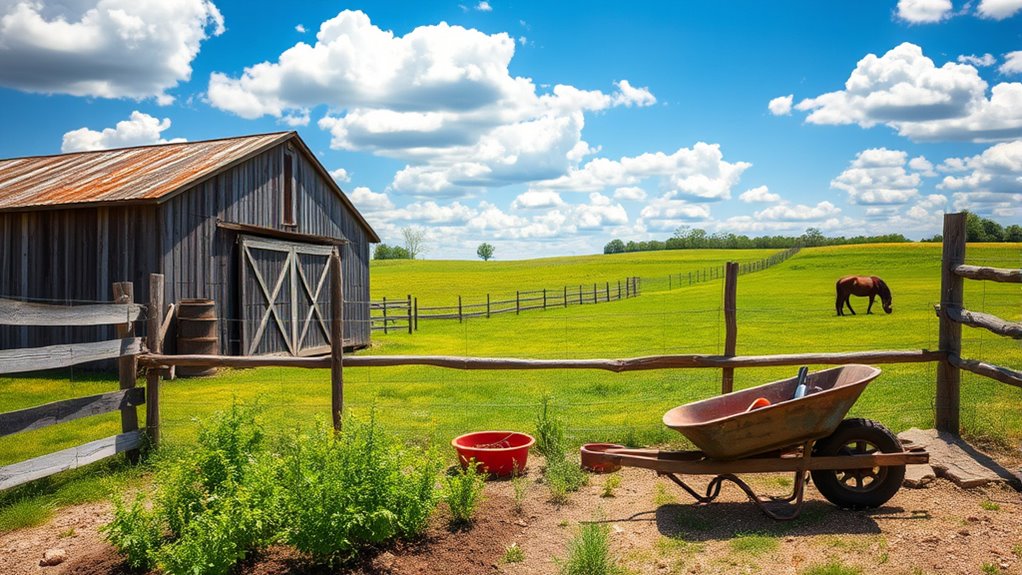Starting a ranch with no money isn't impossible. Focus on maximizing limited resources; buy used equipment and choose essential supplies. Consider leasing land and leveraging community connections for support and knowledge. You can tap into alternative income streams like hunting leases or hosting farm tours. Implement cost-effective strategies and sustainable practices for long-term success. If you explore these ideas further, you'll discover even more strategies to kickstart your ranching journey.
Key Takeaways
- Start with a small initial investment by purchasing essential equipment and supplies second-hand to minimize costs.
- Consider leasing land instead of buying, exploring public grazing or recreational leases to reduce expenses.
- Collaborate with others to share costs and responsibilities, such as forming partnerships for livestock management.
- Engage with local agricultural communities and organizations for support, resources, and networking opportunities.
- Explore alternative income streams, like hosting farm tours or growing high-demand crops, to generate revenue quickly.
Starting Small: Maximizing Limited Resources
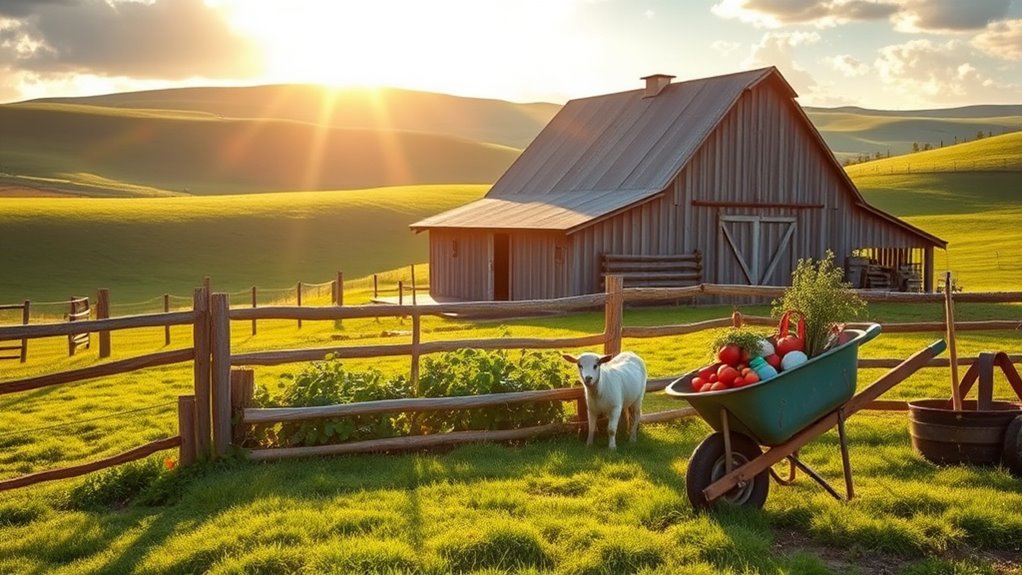
Starting a ranch with limited funds can feel daunting, but by focusing on maximizing your resources, you can lay a solid foundation for your venture.
Begin by keeping your initial investment between $10,000 and $50,000. Prioritize essential equipment and supplies, opting for used or refurbished items to save money. Additionally, consider incorporating mixed herds of sheep and goats into your ranching strategy, as they can coexist and maximize forage usage. Combining livestock types can also lead to more efficient land use and reduced feed costs.
Consider partnering with others to split costs and responsibilities, making it easier to manage your finances. Crowdfunding can also supplement your initial funding, providing a boost to your resources.
Partnering with others can ease financial burdens, while crowdfunding offers a valuable boost to your ranching resources.
Additionally, create a comprehensive business plan outlining your financial projections and operational strategies, which can help secure loans and grants. Understanding clear communication strategies is vital for maintaining partnerships and collaborations effectively.
Regularly review this plan to adapt to changes and ensure continued growth in your ranching journey.
Leasing Land for Cost Efficiency
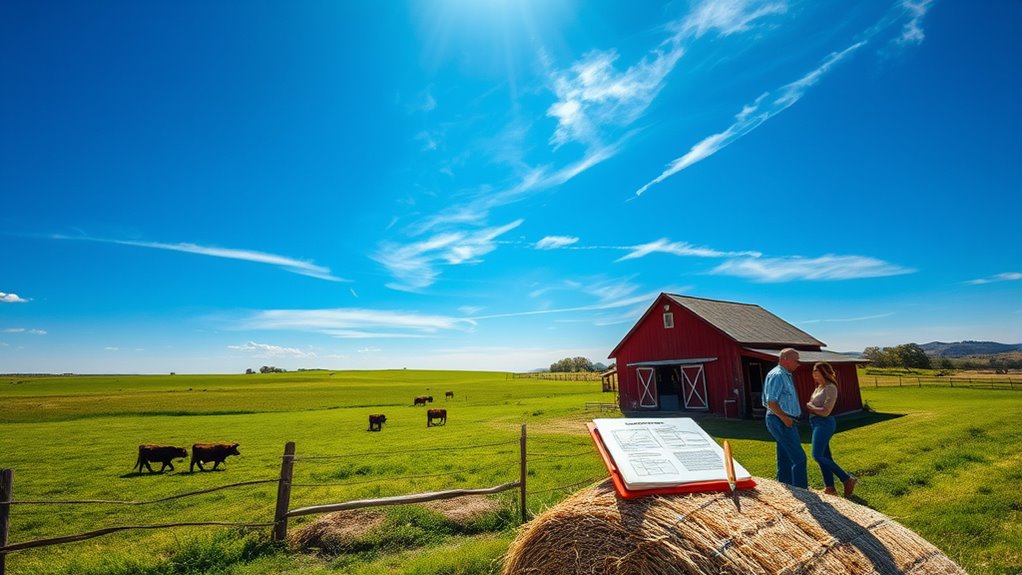
Leasing land can be a strategic way to minimize costs while building your ranching operation. By exploring various lease types, like public grazing or private recreational leases, you can access valuable resources without the hefty price tag of ownership.
This approach not only boosts your grazing capacity but can also generate revenue through specialty leases for events or hunting. Keep in mind, lease rates depend on land type and location, so evaluate your options carefully.
Effective land management is crucial; maintain soil health and infrastructure to ensure your operations thrive. Remember to outline responsibilities clearly in your lease agreements to protect both parties and ensure smooth operations.
With the right planning, leasing can be a key element in your ranching success.
Building Community Connections

While building a ranch from the ground up can feel overwhelming, establishing strong community connections can significantly ease the journey.
Engage with youth organizations like 4-H and FFA; they offer platforms for teaching agricultural skills while fostering relationships with local families.
Participate in county fairs to showcase your products, network with other farmers, and promote agricultural awareness.
Joining agricultural boards opens doors to resources and collaborative opportunities that can benefit your ranch.
Additionally, consider creating or joining networking groups where you can share knowledge and mentorship.
Lastly, utilize social media to organize community events, ensuring everyone feels included.
These connections not only provide support but can lead to valuable partnerships as you grow your ranch.
Utilizing Natural Resources Effectively
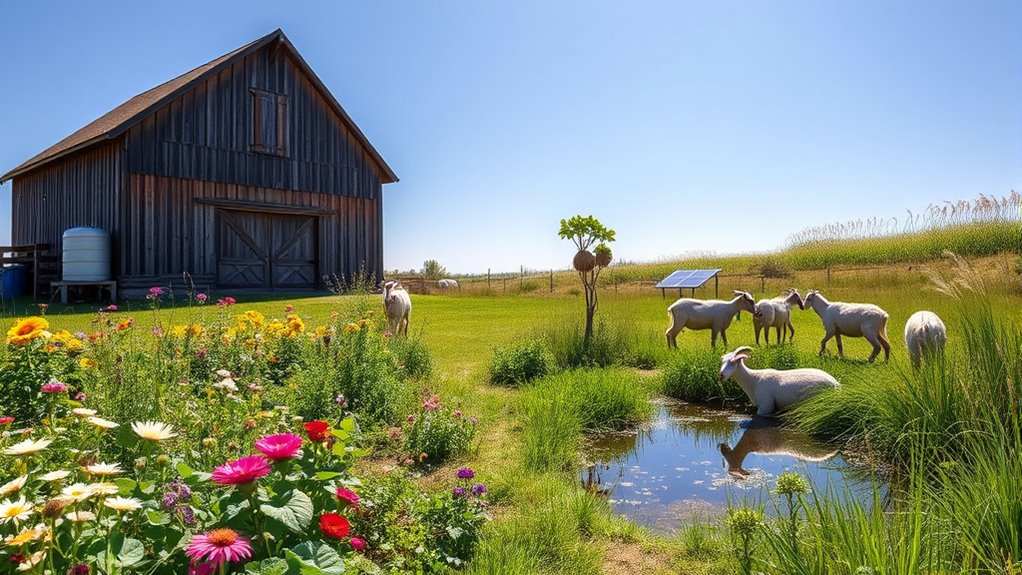
Building strong community connections lays the groundwork for successful ranching, but it's equally important to harness the natural resources at your disposal effectively.
Start by planning land use to optimize grazing areas while aligning with ecological goals. Efficient water management is vital—ensure your water sources are conserved and adequate for livestock. Consider implementing heat pump technology to provide an energy-efficient solution for any necessary temperature control in livestock shelters. Additionally, understanding local supernatural lore can help in avoiding areas that may be culturally significant or believed to be haunted, thus ensuring a harmonious relationship with the land.
Implement soil conservation practices like rotational grazing and cover cropping to maintain soil health. Supporting biodiversity through habitat preservation enhances ecosystem resilience.
Lastly, recognize that your ranch can provide valuable ecosystem services, such as carbon sequestration. By leveraging these natural resources wisely, you'll build a sustainable foundation for your ranching venture without needing significant upfront investment. Additionally, understanding emergency preparedness essentials can further enhance your ranch's resilience during unforeseen challenges.
Exploring Alternative Income Streams

There are numerous ways to generate income on a ranch, even if you're starting with little to no money. One option is leasing land for hunting, which can earn you up to $20 per acre annually.
You can also explore recreational activities through platforms like LandTrust, hosting events like farm tours or bird watching. If you have suitable land, consider offering exotic game hunting for premium clients. Additionally, incorporating smart toilets into your facilities can enhance your guests' experience and potentially increase rental appeal.
Growing high-demand crops like microgreens or pumpkins can yield quick profits. Creating value-added products, such as jams, can enhance your revenue.
Selling timber or mineral rights can provide passive income, while developing vacation rentals or eco-tourism can attract guests seeking unique experiences. Each avenue helps diversify your income streams effectively.
Financial Planning for Sustainability
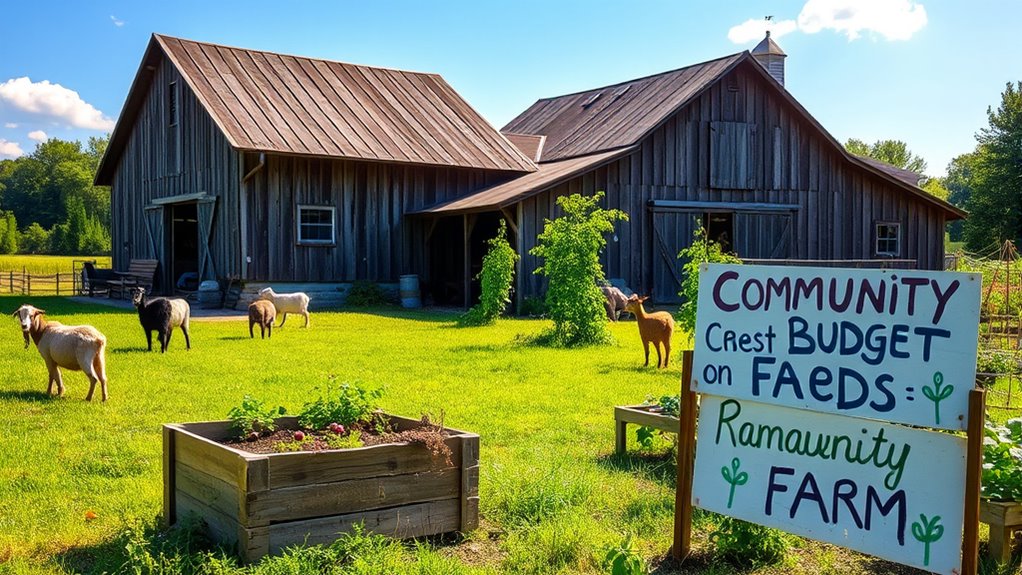
Generating diverse income streams is just one part of running a successful ranch; financial planning for sustainability plays a vital role in ensuring long-term viability.
Start by creating a detailed budget to manage your income and expenses effectively. Understand your financial statements to make informed decisions about operations and investments.
Conduct risk assessments to identify potential threats and develop mitigation strategies. Securing insurance coverage protects against unforeseen events and helps you establish emergency funds as a financial buffer.
Additionally, consider succession and retirement planning to ensure continuity. Regularly review and update your financial plans to adapt to market changes, and explore diversified investments for enhanced stability.
This comprehensive approach sets the foundation for a sustainable ranching future.
Developing Scalable Grazing Strategies
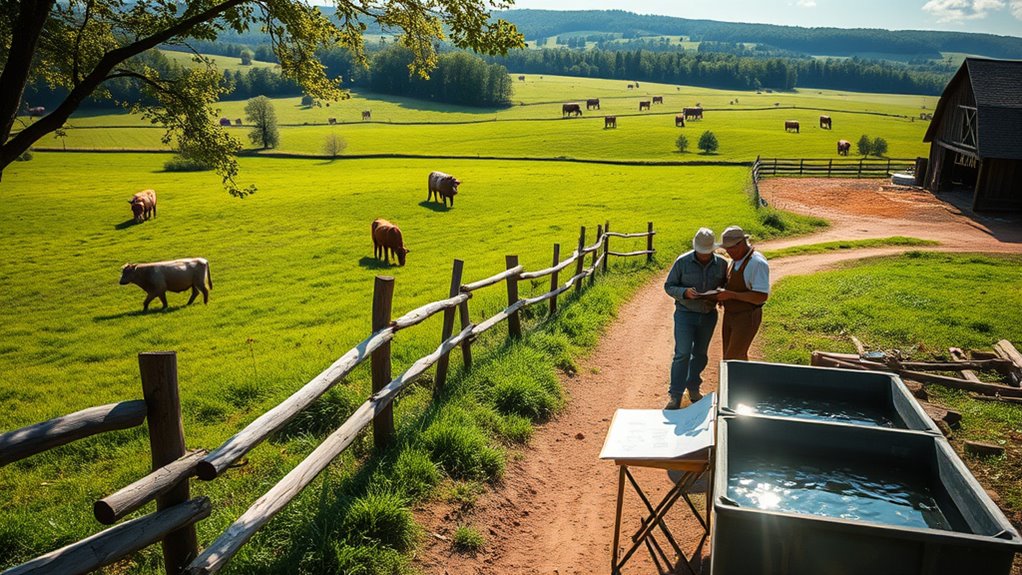
As you embark on developing scalable grazing strategies, focusing on efficient land use can significantly enhance your ranch's productivity.
Start by designing paddocks that allow for controlled grazing and resting periods, ensuring each has adequate water access. Implement flexible fencing to adjust paddocks as needed and create a grazing schedule that aligns with forage growth.
Consider adaptive grazing techniques like high-density short-duration grazing to boost plant health. Monitor vegetation with precision tools to inform your decisions.
Don't forget to manage your strategy seasonally, adjusting plans based on weather and historical growth patterns. Integrating multiple livestock species can also improve pasture utilization and weed control, making your grazing system more resilient and efficient.
Frequently Asked Questions
What Are the Best Livestock Options for Beginners?
When you're starting out, consider livestock that's easy to raise and manage.
Chickens are great for eggs and meat, require minimal space, and can be a fun addition.
Rabbits grow quickly and need little room, while quail offer a unique market option with their eggs and meat.
Pekin ducks are also good choices for small spaces.
Goats provide both milk and meat, making them versatile for beginners like you.
How Can I Find Mentorship in Farming?
To find mentorship in farming, start by exploring local programs like the Cornell Cooperative Extension or the PA Agriculture Mentor Program.
These offer valuable resources and connections with experienced farmers. Attend workshops and networking events to meet potential mentors.
Don't hesitate to reach out to organizations like SCORE for additional guidance. Tailor your search based on your specific goals, and be open to learning from the diverse experiences of other farmers.
What Permits Do I Need to Start a Ranch?
To start a ranch, you'll need several key permits. First, get a business license from your local municipality.
You'll also need an Employer Identification Number (EIN) for tax purposes.
Check zoning regulations to ensure your land's use complies.
Depending on your operations, you may require environmental and health permits, especially if selling food.
Lastly, consider USDA registration for federal compliance and local agricultural registration for additional support.
How Do I Determine the Right Size for My Ranch?
Deciding the right size for your ranch isn't just about space; it's about purpose.
You'll need to define your goals—whether it's livestock, crops, or recreation. Assess land efficiency to maximize productivity while staying within budget constraints.
Consider future growth and environmental impact, too. Evaluate forage availability, water access, and soil quality.
Balancing these factors will help you determine the ideal size for your ranch, ensuring it meets your needs and aspirations.
What Insurance Do I Need for a Small Ranch?
You'll need several types of insurance to protect your small ranch effectively.
Start with dwelling coverage for your home and farm personal property coverage for your equipment and livestock.
Liability coverage is crucial for any accidents on your property.
If you employ workers, get workers' compensation insurance.
Don't forget about specialized options like livestock and equipment breakdown insurance to safeguard your assets.
Regularly review your policies to ensure they meet your changing needs.
Conclusion
Starting a ranch with little to no money might seem daunting, but it's possible with creativity and determination. Did you know that nearly 70% of new farmers face financial challenges in their first few years? However, by leveraging community resources and focusing on sustainable practices, you can create a thriving ranching operation. Embrace the journey, stay resourceful, and remember that every small step can lead to remarkable growth in your ranching dreams.

